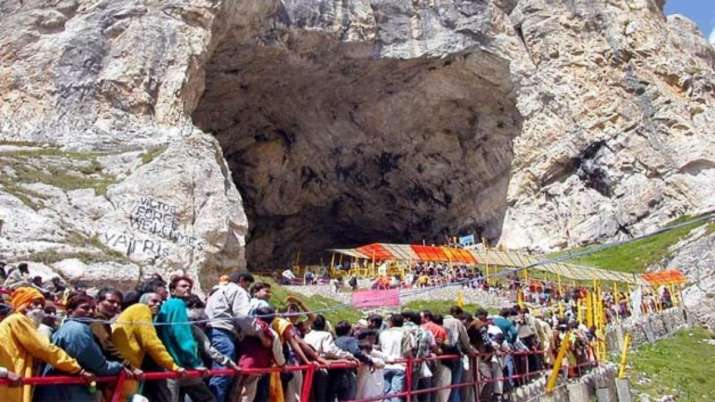In the enchanting heart of the Himalayas, where snow-laden peaks soar into the heavens and silence wraps the landscape like a sacred hymn, lies a mystical cave steeped in legend and devotion the Amarnath Cave. Nestled at an altitude of over 12,700 feet in the Union Territory of Jammu and Kashmir, this cave is not just a natural marvel but a divine sanctuary. It is revered as the abode of Lord Shiva and is also closely associated with Goddess Parvati, regarded as one of the sacred Shakti Peethas, known as the Mahamaya Shakti Peeth. The cave is about forty yards wide and seventy-five feet high, sloping 80 feet deep into the mountain and contains three stalagmites symbolizing Lord Shiva, Goddess Parvati and Lord Ganesha. Here, spiritual transcendence and physical endurance blend into a profound pilgrimage known as the Amarnath Yatra.
The legend behind Amarnath is deeply rooted in ancient Hindu mythology. It is believed that Lord Shiva, the Supreme Yogi and the Destroyer in the Holy Trinity, chose this remote cave to disclose the secrets of immortality Amar Katha to his divine consort, Goddess Parvati. In his quest for solitude and detachment from all worldly distractions, Shiva left behind all his belongings – Nandi the bull at Pahalgam, the moon from his hair at Chandanwari, the snakes at Sheshnag and his son Ganesha at Mahagunas Top – before arriving at the cave with Parvati alone. The very names of the places along the route commemorate these celestial milestones. As the divine couple entered the cave, a pair of pigeons are said to have overheard the secret conversation. Blessed unknowingly by the Lord himself, they were granted immortality. Even today, many pilgrims report spotting these pigeons during the Yatra, taking it as a sign of divine presence and auspicious blessings. References to Amarnath are also found in the epic Rajtarangini, written by Kalhana in the 12th century CE, in which he mentions Queen Suryamati, who built Mathas at Amareshwar – further highlighting the significance of Amarnath in ancient India.
The modern history of the Amarnath Cave traces back to the 15th century, when it was rediscovered by a Muslim shepherd named Buta Malik. As the legend goes, a saint gave him a bag full of coal, which turned into gold when he reached home. Filled with gratitude and wonder, Malik returned in search of the holy man, only to find the sacred cave and the naturally formed ice lingam the divine symbol of Lord Shiva. This miraculous event marked the beginning of what is now known as the Amarnath Yatra. To this day, Buta Malik’s descendants and the local Gujjar and Bakarwal communities play a significant role in organizing and facilitating the pilgrimage, showcasing a rare and beautiful example of interfaith harmony and shared reverence. There are two primary routes to reach the cave. The traditional route starts from Pahalgam, passing through Chandanwari, Sheshnag and Panchtarni. The alternative, shorter but steeper route begins from Baltal and traverses through Domail and Sangam. Both routes are rich with mythological and natural significance, offering stunning views and testing the pilgrims’ resolve and devotion.
Historically, the first organized yatras were humble in scale, with pilgrims trekking through treacherous terrain, braving icy winds, snow-covered paths and unpredictable weather. In 1895, the yatra became more structured. Pilgrims began their journey with a brief but sacred halt at the shrine of Kheer Bhawani in Tulmulla, a temple dedicated to Goddess Ragnya Devi. A vibrant mela is held here annually on Jyeshtha Ashtami, attracting thousands who offer prayers and seek the goddess’s blessings. The state, acknowledging the spiritual importance of the yatra, provided free rations to sustain the pilgrims. From there, they journeyed to Srinagar and then, in organized batches, made their way into the captivating Lidder Valley, pausing at sacred spots to bathe in holy streams and prepare for the final ascent.
During the sacred Amarnath Yatra, the Indian Army becomes a pillar of strength and devotion – guiding pilgrims through the rugged mountains with care, clearing treacherous paths, setting up shelter camps, offering timely medical aid and ensuring their safety at every step. Their presence transforms a daunting journey into a serene and spiritual passage. To further fortify this divine pilgrimage, Operation Shiva is launched each year – a dedicated security mission marked by vigilance, compassion and unwavering commitment, ensuring that every devotee walks under the protective gaze of the nation’s guardians.
Today, the Amarnath Yatra stands as a timeless symbol of India’s spiritual legacy. Despite the physical challenges of high altitudes, rugged terrain and unpredictable weather, millions undertake the pilgrimage each year, driven by unwavering faith and devotion. The journey not only honors the sacred mythology of Lord Shiva but also embodies the enduring resilience and unity of India’s spiritual consciousness.


